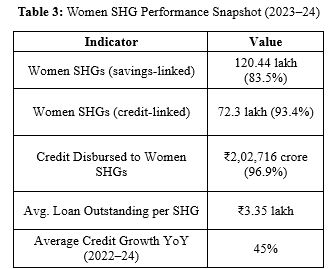Digital Financial Inclusion and Self-Help Groups in India: A Theoretical Review into Empowerment, Credit Linkage, and Sustainable Development
DOI:
https://doi.org/10.5281/zenodo.16447073Keywords:
digital financial inclusion, economic growth, government policies, living standards, self-help groupsAbstract
Introduction: Over the past few years, self-help organizations have advanced in the Indian economy thanks in large part to digital financial inclusion. Through the many facets of the digital financial inclusion process, the Joint Liability Groups (JLG) and Farmer Interest Groups (FIG) are also making progress in their social inclusion and economic growth. Point of Sale (POS) counters, Adhar-enabled payment methods, Core Banking System (CBS), and various Unified Payment Interfaces (UPI) are all playing a significant role in creating the nation's digital ecosystem and fostering a close relationship with the country's semi-urban and rural areas through digital financial inclusion.
Objective of the study: The study's goals are to determine if the process of digital financial inclusion has any bearing on the financial advancements of Self-Help Groups (SHGs) in India and to evaluate the effects of various government initiatives implemented thus far to enhance the same. Another aspect of this study is how DFI creativity and SHGs may work together to help India achieve the SDGs.
Methodology: Information gathered from various government websites, journals, magazines, newspapers, and e-books forms the basis of the theoretical research with the case study. Additionally, this study uses quarterly NABARD reports as an additional quantitative data source.
Results: Enterprises for Digital Financial Inclusion (DFI), which have a massive potential to advance sustainable development improvements in the Indian economy, have a substantial influence on self-help groups (SHGs). The actual empowerment of Self-Help Groups (SHGs) has been transmuted by the incorporation of digital technology and financial services, which has subsequently assisted in the socioeconomic progression of communities around the world. Subsequently, this empowerment has elevated household incomes, assisted fight against poverty, and boosted living circumstances for semi-urban and rural residents.
Downloads
References
Bansal, S., & Garg, I. (2022). Evaluating the role of digital financial literacy in inclusive rural banking. International Journal of Bank Marketing, 40(4), 715–733. https://doi.org/10.1108/IJBM-10-2021-0394.
Gupta, S., & Sengupta, D. (2022). Digital financial services and women’s economic empowerment in India: A policy perspective. Journal of Development Policy and Practice, 7(1), 43–62. https://doi.org/10.1177/24551333221074989.
Jha, R., & Sinha, R. (2022). Financial inclusion and digital penetration among rural women: A study of post-pandemic shifts in India. Journal of Rural Development, 41(1), 75–91. https://doi.org/10.25175/jrd/2022/v41/i1/167351.
Kumari, R., & Paul, B. (2023). Impact of SHG-bank linkage programme on women’s entrepreneurship in Eastern India. Asian Journal of Women's Studies, 29(2), 180–198. https://doi.org/10.1080/12259276.2023.2198894.
Mitra, D., & Das, S. (2022). Digital microfinance for SHGs: Challenges and policy directions in Indian states. Indian Journal of Economics and Development, 18(4), 310–320. https://doi.org/10.17485/ijed/v18i4.244.
Mehrotra, S., & Sharma, A. (2021). Digital inclusion and financial empowerment in India. Journal of Economic Policy and Research, 16(1), 60–75.
Nair, T. S., & Tankha, A. (2015). Inclusive finance India report 2014. New Delhi: Oxford University Press.
NABARD. (2024a). Status of microfinance in India 2023–24. National Bank for Agriculture and Rural Development. https://www.nabard.org.
NABARD. (2024b). Impact of bank linkage programme on self-help groups: Achievements, challenges and the way forward (Issue No. 04). Department of Economic Analysis and Research (DEAR), NABARD.
Pathania, M., & Gupta, H. (2023). Evaluating the impact of fintech on SHG performance: A case-based analysis from Northern India. International Journal of Social Economics, 50(3), 295–312. https://doi.org/10.1108/IJSE-07-2022-0451.
Reserve Bank of India. (2022). Financial inclusion in India: A review. https://www.rbi.org.in.
Singh, R., & Kaur, J. (2020). Empowerment through Self-Help Groups: A case study from rural India. International Journal of Rural Studies, 27(2), 45–56.
Sharma, V., & Kiran, R. (2022). Assessing the digital transformation of SHGs under the NRLM framework. South Asian Journal of Business and Management Cases, 11(1), 23–34. https://doi.org/10.1177/22779779221081094.
Thomas, A., & Chatterjee, P. (2023). Financial resilience and digital inclusion among Indian women: A micro-level analysis. Gender in Management: An International Journal, 38(1), 134–152. https://doi.org/10.1108/GM-12-2021-0410.
World Bank. (2020, 2021, 2022). Digital financial services and the road to SDGs. https://www.worldbank.org.

Published
How to Cite
Issue
Section
License
Copyright (c) 2025 Ayushee N Rao, Ramishah, Bharat Sarkar, Uttiya Basu

This work is licensed under a Creative Commons Attribution 4.0 International License.
Research Articles in 'Management Journal for Advanced Research' are Open Access articles published under the Creative Commons CC BY License Creative Commons Attribution 4.0 International License http://creativecommons.org/licenses/by/4.0/. This license allows you to share – copy and redistribute the material in any medium or format. Adapt – remix, transform, and build upon the material for any purpose, even commercially.









